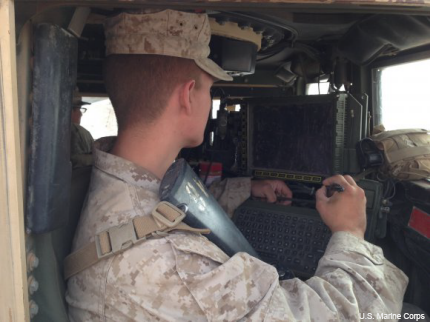Army, Marines get new blue force tracking system a step closer
The user friendly, mobile battlefield command and control tool gets a workout during NIE exercises at Fort Bliss.

The Army’s system for mobile, joint-forces battlefield communications went for an extended test drive with the Army and Marine Corps working together during the recent Network Integration Evaluation 14.2 at Fort Bliss, Texas.
The Joint Battle Command-Platform, generally mounted in vehicles, provides a way to track friendly forces and plot enemy forces and other hazards via an easy-to-use interface that includes drag-and-drop icons, zoomable maps and Google Earth-like views.
JBC-P also connects to the Nett Warrior system, with which dismounted soldiers use tailored Android smartphones to get the operational picture and communicate. For this latest test, the system had faster satellite communications, upgraded chat messaging and secure encryption. The result is a complete picture of the battlefield that enables better situational awareness and command and control, the Army said in a release.
"This interface is far more user-friendly," Marine Corps 1st Lt. Jeffrey Weinmeister said in the Army release. "It makes it very easy for the first-time user to effectively perform command and control operations. The reliability of the system has allowed us to use it over very difficult terrain here, as well as communicate from significant distances and maintain our situational awareness of the battlefield."
JBC-P is the newest iteration of the Force XXI Battle Command Brigade-and-Below/Blue Force Tracking system currently on more than 120,000 platforms and is fielded or authorized to all of the Army’s brigades, the Army said.
A key focus of the NIEs—and the military’s battlefield communications overall—is the ability to meet the needs of joint U.S. forces and multinational partners. The exercises at Fort Bliss involved the Army's 2nd Brigade Combat Team, 1st Armored Division along with a 900-member Marine batallion, and were conducted in conjunction with the Joint Staff’s BoldQuest exercise staged primarily at White Sands Missile Range, N.M., with joint U.S. forces and representatives from 13 countries.
The Marines, for example, have been expanding their role in the exercises. About 40 Marines took part in developmental tests for JBC-P in November 2013. For the recent operational test, a full battalion plus a company of amphibious assault vehicles joined in, the Marine Corps said.
The semi-annual NIEs, started in 2011, are designed to test systems and improve them based on soldier feedback, eventually deploying them to the field. JBC-P was one of 12 systems being evaluated at Fort Bliss, and overall the NIEs have tested and evaluated more than 170 systems.




